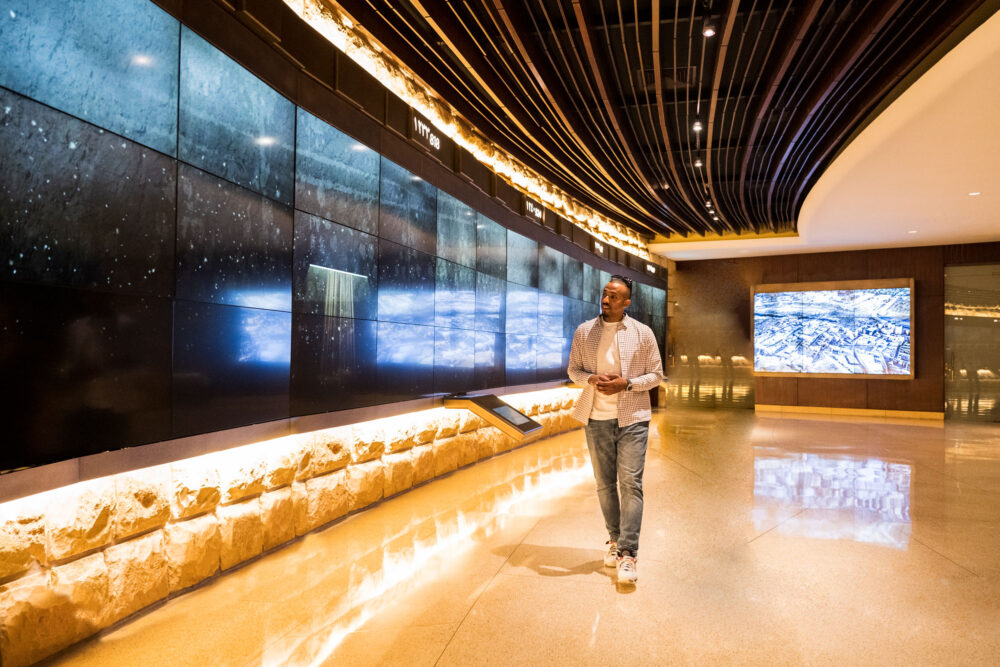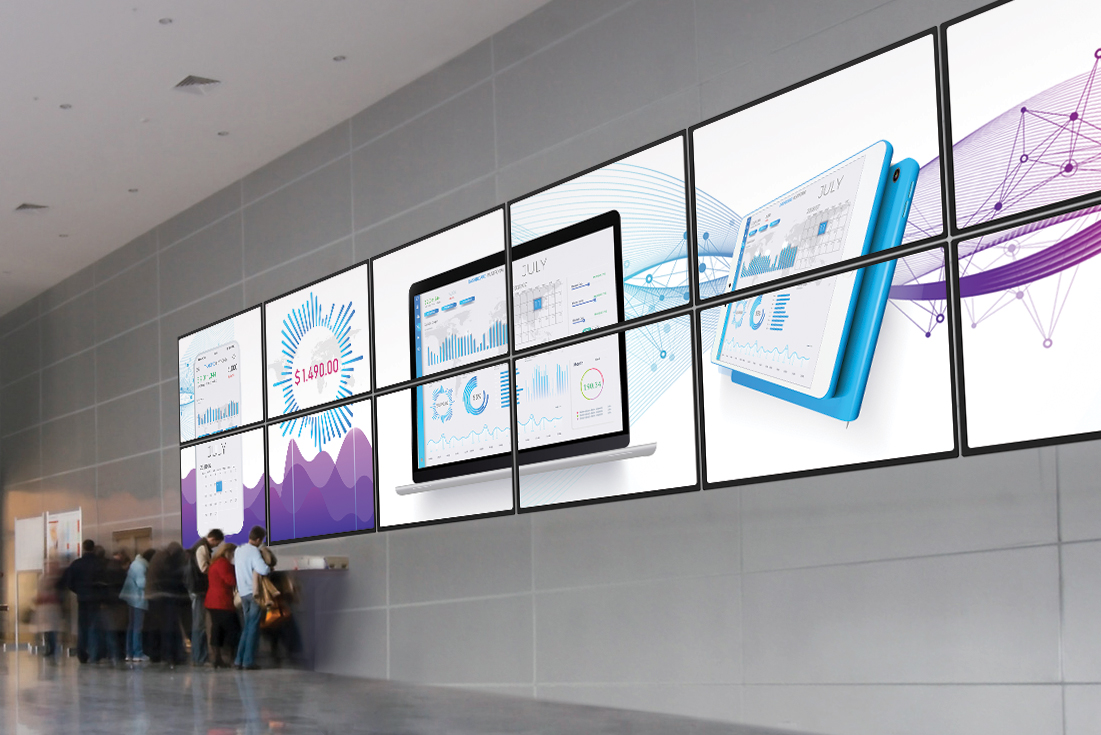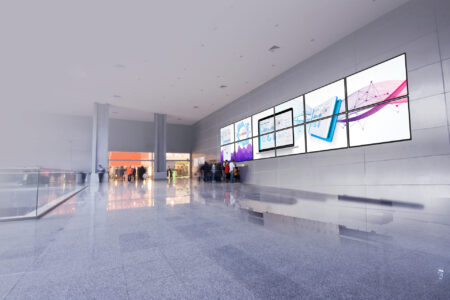August 27, 2024
What is a video wall? Its techs (AVSM vs. AVoIP) and use cases

What is a video wall? This question opens the door to a world where technology transforms walls into expansive canvases of light and color. Video walls aren’t just about broadcasting images; they create immersive experiences that attract attention and drive interaction.
In this blog post, we uncover the technologies and applications that make video walls a powerhouse tool across various sectors. We start by explaining what a video wall is, continue to explore the video wall technology, and review the video walls’ use cases.
What is a Video Wall?
A video wall is a collection of tile displays of different sizes, arranged together to form a single, large display. It offers an economical and versatile solution for displaying images and videos in a variety of settings, both indoors and outdoors.
It can be provided in various configurations, such as 2×2, 6×4, and even 16×9, and show different content on each screen or work as one large, seamless display. It can be made from various display technologies, such as LCD or LED.
The video wall’s large and captivating display is an effective tool for branding purposes, attracting the attention of customers, employees, and visitors alike. It supports various content simultaneously, making it useful for displaying directions, schedules, and live updates in the education and healthcare sectors. In the realm of retail, it has been proven to enhance customer satisfaction and even boost sales.
Use cases for video walls
Video walls are used across various industries. Here are some common use cases:
Retail and signage
Video walls are extensively used in retail environments to create impactful advertising displays. They capture the attention of customers and can dynamically showcase products, promotions, and brand content.
Manufacturing and facilities
In factory settings, video walls are employed to display comprehensive data about every machine on the manufacturing floor.
Entertainment and events
Concerts, festivals, and sports stadiums utilize video walls to enhance the viewer experience by broadcasting live actions, replays, and interactive entertainment, ensuring all attendees have a good view regardless of their seating.
Command and control rooms
Video walls are crucial in control rooms. They allow operators to monitor multiple streams of information simultaneously and make real-time decisions based on comprehensive data visualizations.
Broadcasting
Television studios use video walls to display content during news broadcasts, weather reports, and talk shows. They provide a dynamic backdrop that can change according to the segment being aired.
Education and museums
Educational institutions and museums use video walls to create interactive learning experiences and exhibitions. They can display multimedia content that enhances visitor engagement and learning.
Each of these use cases highlights the versatility and functionality of video walls, making them vital tools for enhancing visual communication and engagement across various sectors.
The video wall technology
The video wall technology is straightforward and can be seamlessly integrated using either AVSM connections or AVoIP technologies, each catering to different technical needs and environments.
AVSM (Uncompressed)
AVSM (Audio Video Signal Management) represents a class of solutions engineered to transmit high-resolution audio and video signals without any compression, latency, or signal processing. This is crucial for maintaining pristine signal quality across professional AV systems. AVSM is commonly used in environments where flawless AV content delivery is essential—such as professional presentations, meetings, and live events—and facilitates optimal AV communication.
The AVSM video wall system typically involves simple, local connections. Since the display content is uncompressed and the source is directly connected to the screens via cables behind the video wall, it ensures minimal latency and optimal quality.
The AVSM video wall is controlled by a designated processor, through which the operator can select the correct setting to display the content in different arrangements. For instance, if the content quality is 4K or 1080p and the user is using 100 (10×10) small screens, it is possible to scale the entire image on the video wall. The processor then divides it appropriately, ensuring it displays correctly on the video wall.
There are several types of video wall processors in AVSM technology, depending on the type of screens that the video wall comprises:
LED monitors
When a video wall comprises LED monitors, each LED monitor has its own interface. The processor distributes the content across the screens as directed by the operator. The processor is independent of the screen’s manufacturer, meaning any LED processor can fit any LED monitor. Typically, the interface used is HDMI. In addition, when without frames, assembling multiple LED monitors side by side creates the illusion of a single, expansive display—a video wall.
LED panels
LED panels are commonly used in signage and large screens in areas requiring high brightness. Their interface differs from that of LED monitors. While they receive HDMI signals as input, the LED panels’ output is in the electrical format specific to that particular manufacturer. Meaning that LED panels are proprietary. Therefore, when constructing LED video walls, a dedicated processor is necessary to manage and coordinate the panels effectively; the manufacturer of the LED panels and the processor must be the same.
AVoIP (Compressed)
AVoIP (Audio Video over Internet Protocol) technology facilitates dynamic, IP-based transmission of audio, video, and control signals across standard IP networks. It encodes source AV signals into IP packets, which are then transmitted and decoded at the receiving end.
Video walls can utilize AVoIP, which greatly enhances their flexibility and scalability in displaying content. This technology stands out for its ability to swiftly switch setups, providing dynamic actions over IP that are ideal for environments requiring rapid changes in display configurations.
AVoIP is particularly suited for expansive digital video wall systems found in settings such as command and control centers, signage networks, and large venue live events. It supports long-range signal transmission, easy reconfiguration, and centralized management, and is a cost-effective alternative to traditional AV setups.
When using AVoIP, the video wall system and setup require a single encoder, eliminating the need for a separate controller. The content is split within the decoder, and the encoder can be located remotely. The real advantage of AVoIP (Audio Video over Internet Protocol) technology lies in its scalability and flexibility, which are crucial for large-scale applications. Each monitor equipped with its own decoder functions as an independent unit within the entire video wall setup. This arrangement provides tremendous flexibility; users can distribute images or videos across multiple screens, regardless of the number or configuration of the displays.
The video wall can be divided into segments, with different content streams allowed in each section, each granularity adjusted, or content displayed on one-third of the wall and different content on the remaining two-thirds.
Conclusion, and the future of video walls
As we investigate what a video wall is and look to the future of video wall technology, we can see that its popularity in various industries is bound to grow, thanks to this technology’s versatility, scalability, and flexibility. The potential developments in video wall capabilities also hint at greater resolutions, larger scales, and more seamless integration with other digital systems, making them a cornerstone in digital signage, entertainment, corporate, and even urban planning applications.
In addition, the advancements in display technology are pushing the boundaries of brightness, contrast, and energy efficiency. These developments promise thinner, more flexible, and more scalable video walls that can be adapted to various architectural styles, further integrating digital media into physical spaces. As video walls become smarter and more connected, their role in our daily lives and professional environments will undoubtedly expand, making them an even more vital tool in the digital age.







